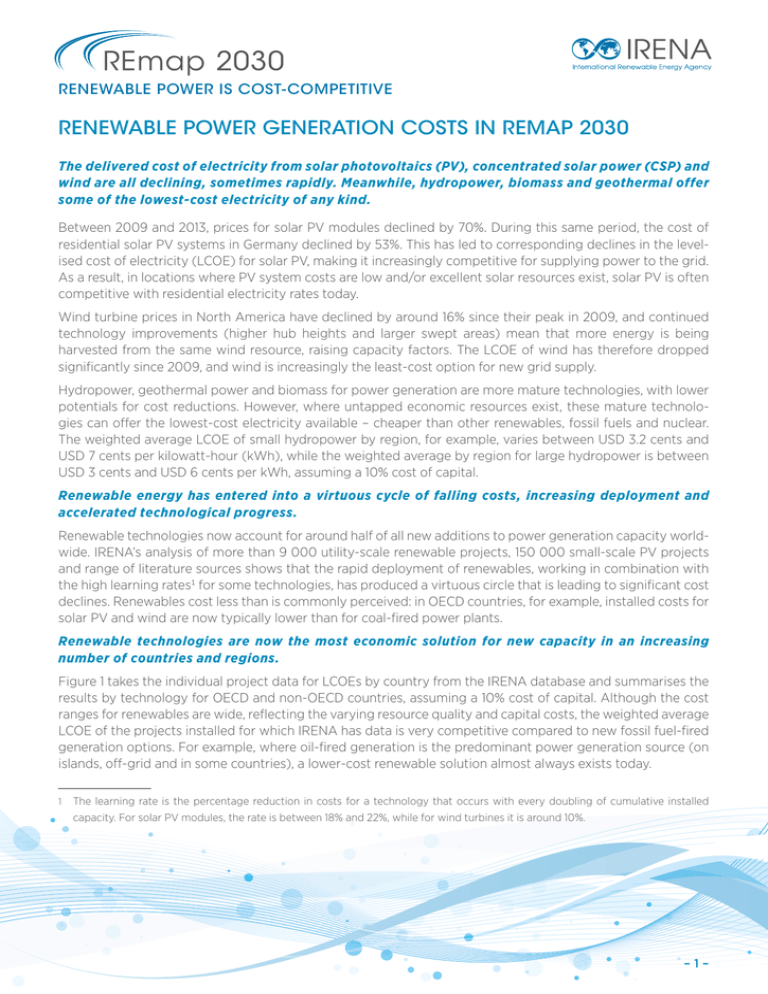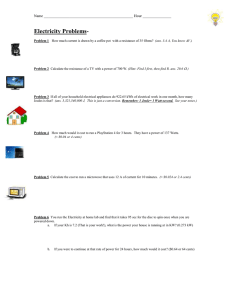Factsheet 07: Renewable Power is Cost-competitive
advertisement

RENEWABLE POWER IS COST-COMPETITIVE RENEWABLE POWER GENERATION COSTS IN REMAP 2030 The delivered cost of electricity from solar photovoltaics (PV), concentrated solar power (CSP) and wind are all declining, sometimes rapidly. Meanwhile, hydropower, biomass and geothermal offer some of the lowest-cost electricity of any kind. Between 2009 and 2013, prices for solar PV modules declined by 70%. During this same period, the cost of residential solar PV systems in Germany declined by 53%. This has led to corresponding declines in the levelised cost of electricity (LCOE) for solar PV, making it increasingly competitive for supplying power to the grid. As a result, in locations where PV system costs are low and/or excellent solar resources exist, solar PV is often competitive with residential electricity rates today. Wind turbine prices in North America have declined by around 16% since their peak in 2009, and continued technology improvements (higher hub heights and larger swept areas) mean that more energy is being ­harvested from the same wind resource, raising capacity factors. The LCOE of wind has therefore dropped significantly since 2009, and wind is increasingly the least-cost option for new grid supply. Hydropower, geothermal power and biomass for power generation are more mature technologies, with lower potentials for cost reductions. However, where untapped economic resources exist, these mature technologies can offer the lowest-cost electricity available – cheaper than other renewables, fossil fuels and nuclear. The weighted average LCOE of small hydropower by region, for example, varies between USD 3.2 cents and USD 7 cents per kilowatt-hour (kWh), while the weighted average by region for large hydropower is between USD 3 cents and USD 6 cents per kWh, assuming a 10% cost of capital. Renewable energy has entered into a virtuous cycle of falling costs, increasing deployment and accelerated technological progress. Renewable technologies now account for around half of all new additions to power generation capacity worldwide. IRENA’s analysis of more than 9 000 utility-scale renewable projects, 150 000 small-scale PV projects and range of literature sources shows that the rapid deployment of renewables, working in combination with the high learning rates1 for some technologies, has produced a virtuous circle that is leading to significant cost declines. Renewables cost less than is commonly perceived: in OECD countries, for example, installed costs for solar PV and wind are now typically lower than for coal-fired power plants. Renewable technologies are now the most economic solution for new capacity in an increasing number of countries and regions. Figure 1 takes the individual project data for LCOEs by country from the IRENA database and summarises the results by technology for OECD and non-OECD countries, assuming a 10% cost of capital. Although the cost ranges for renewables are wide, reflecting the varying resource quality and capital costs, the weighted average LCOE of the projects installed for which IRENA has data is very competitive compared to new fossil fuel-fired generation options. For example, where oil-fired generation is the predominant power generation source (on islands, off-grid and in some countries), a lower-cost renewable solution almost always exists today. 1 The learning rate is the percentage reduction in costs for a technology that occurs with every doubling of cumulative installed ­capacity. For solar PV modules, the rate is between 18% and 22%, while for wind turbines it is around 10%. –1– RENEWABLE POWER IS COST-COMPETITIVE Figure 1: Summary of the LCOE of renewable energy technologies in OECD and non-OECD countries 0.60 Diesel-fired electricity cost range 0.40 0.30 0.20 OECD Geothermal Hydro Large Hydro Small Biomass Solar PV: small Solar PV: large CSP Onshore wind Geothermal Hydro Large Hydro Small Biomass Solar PV: small Solar PV: large CSP 0.00 Offshore wind Fossil fuel-fired electricity cost range in OECD 0.10 Onshore wind LCOE in (USD2012 /kWh) 0.50 Non-OECD CSP and utility-scale solar PV are more expensive, but in the latter case the power is often competing not with utility-scale generators, but with retail electricity tariffs as a distributed option. The weighted average LCOE for utility-scale solar PV varies between USD 15 cents and USD 31 cents per kWh. The weighted average LCOE for CSP for a region varies between USD 22 cents and USD 25 cents per kWh. For more information on the costs and performance of renewable power technologies and to view the underlying data, visit www.irena.org/costs. Th e Int e r na t iona l Re n ewa b l e E n e r g y Ag e n cy ( I R EN A ) i s a n i nt er gover nm ent a l o r ga ni s a t i o n p ro m o t in g the wid e s pread an d i n c re as e d adop ti on an d s us t a i na bl e us e o f a l l fo r m s o f renewa bl e ener gy wo r l d w id e , ­i nclud ing bioen e r g y, g e oth e r m al e n e r g y, hy d ro p ower, o cea n ener gy, w i nd ener gy a nd s o l a r ener gy. w ww.ire na.or g –2– Fac t sh e et 07: Re n ewa b le Power is C o s t-c o mpet it ive For biomass, the weighted average LCOE for non-OECD countries varies between USD 5 cents and USD 6 cents per kWh. For geothermal, the weighted average LCOE is between USD 5 cents and USD 9 cents per kWh, with an average of USD 5.5 cents per kWh in non-OECD countries and USD 9 cents per kWh in OECD countries. The LCOE range for onshore wind is between USD 8 cents and USD 12 cents per kWh, depending on the region, with an average of USD 10 cents per kWh in the OECD countries and USD 7.6 cents per kWh in non-OECD countries.



